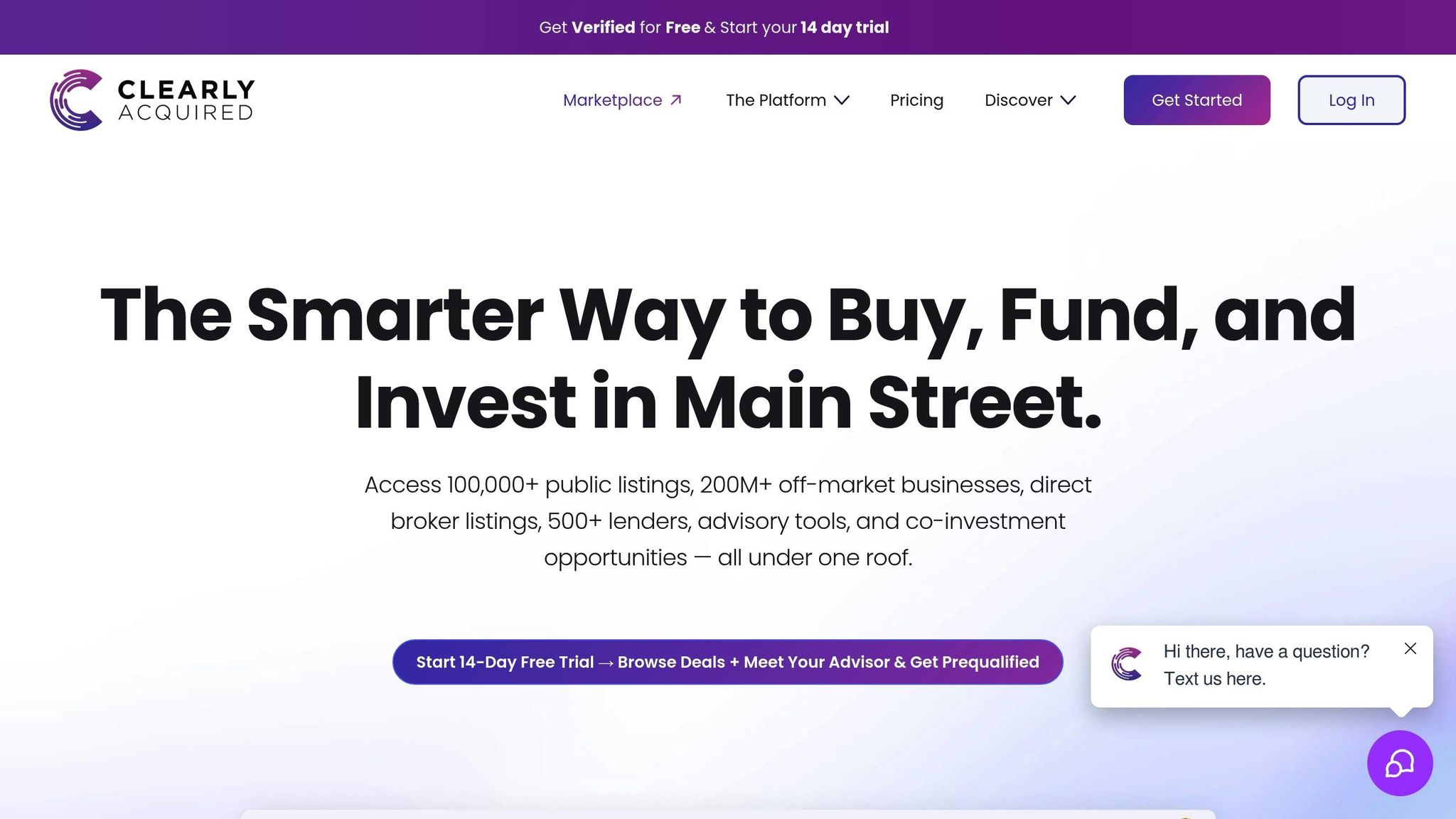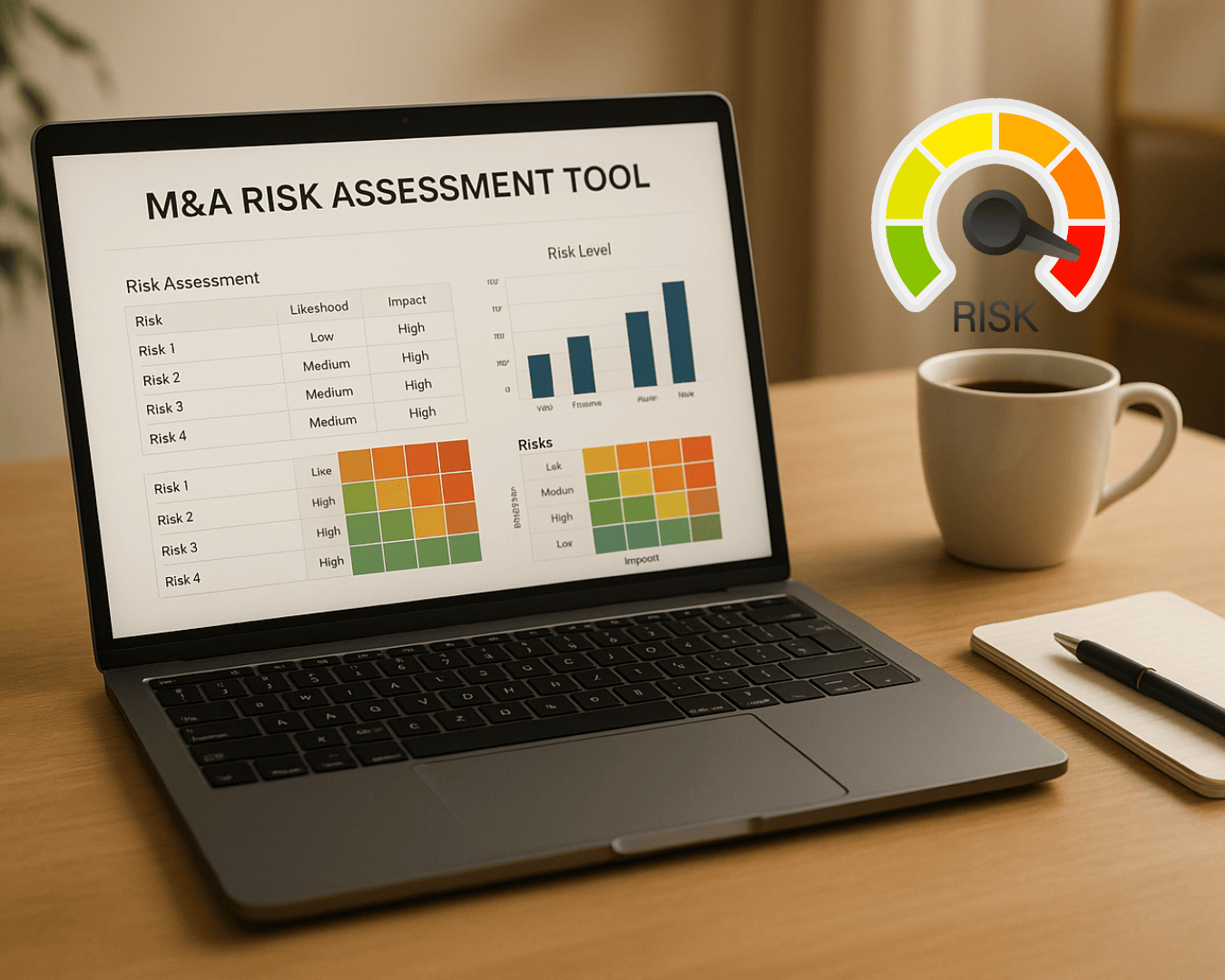Unrealistic seller valuations are one of the biggest barriers to closing business deals. Many sellers overestimate their business's worth due to emotional ties, hearsay, or personal financial needs. This disconnect often leads to delays, failed negotiations, or abandoned sales.
Key Takeaways:
- 70% of deals face delays or fall apart due to valuation disagreements.
- Sellers often base prices on emotions, incomplete data, or financial goals rather than market realities.
- Using market data like industry multiples, comparable sales, and trends can help reset expectations.
- Neutral experts and clear communication are essential to bridging valuation gaps.
- Flexible deal structures like earnouts or seller financing can address mismatched expectations.
By focusing on data-driven discussions and understanding seller motivations, buyers can navigate these challenges effectively while maintaining constructive negotiations.
Seller Financing & Valuation Negotiation Tips To Avoid Over-Paying For a Business!
Why Sellers Overvalue Their Businesses
To negotiate effectively, it's crucial to understand why sellers often set prices that don't align with market realities. Overpricing usually stems from a mix of emotional, anecdotal, and financial factors that skew a seller's perspective, creating a disconnect between their expectations and the market's assessment. Recognizing these biases is the first step toward bridging this gap.
Emotional Attachment and Personal Investment
For many business owners, their company represents years of hard work, sacrifice, and personal milestones. This emotional connection often leads to an inflated sense of value. Owners may mistakenly equate their personal effort with the business's worth, making it difficult to view their company through an objective lens. As a result, lower offers can feel like a personal insult rather than a reflection of market conditions.
Relying on Hearsay and Isolated Examples
Some sellers base their pricing expectations on anecdotal evidence or casual industry chatter. They might hear about another business selling for a high multiple and assume their own company should command the same - without accounting for differences in market conditions or the unique circumstances of those deals. For example, a business that sold at a premium during a booming market might not fetch the same value in today's environment. This reliance on incomplete or outdated information often leads to unrealistic expectations.
Personal Financial Needs vs. Market Value
Another common factor is the seller's financial situation. Many business owners tie their personal financial goals - such as funding retirement or paying off debts - to the sale of their business. When their financial needs exceed what the market is willing to pay, sellers may cling to inflated valuations, making negotiations more challenging.
"By defining the personal financial goals that are important to you and your family, you can then begin to understand the issues that need to be addressed in order to accomplish those goals." - Noah Harden, SVP, National Wealth Planning Manager, Comerica Wealth Management
For instance, if a seller expects the sale to cover a specific financial target that surpasses the business's actual market value, it can create a significant gap that even the best negotiation strategies might struggle to close.
Using Market Data to Show Realistic Valuations
Once you understand why sellers tend to overvalue their businesses, the next step is presenting hard market data to show what their company is actually worth. Numbers speak louder than opinions, and when sellers see clear data from reliable sources, they’re more likely to align their expectations with market realities.
Core Valuation Methods
A meaningful valuation discussion starts with widely accepted methods used by financial experts. Two key approaches are Comparable Company Analysis (CCA) and Comparable Transaction Analysis (CTA). CCA assesses a business by comparing it to similar companies using publicly available multiples, while CTA looks at past transactions involving similar businesses to establish a baseline for value. The logic is straightforward: businesses in the same category should have similar valuations.
"Valuations using multiples is one of the three main approaches to valuing a business, sometimes referred to as the 'market-based approach.'" – Valutico
For example, if businesses in a particular industry typically sell for 2.5 times their annual earnings, that multiple provides a realistic benchmark for valuing a seller’s company. Enterprise Value multiples like EV/EBITDA are often preferred because they allow for consistent comparisons across companies, regardless of their financial structures. This approach gives a clearer picture of operational value.
Position these methods as the industry standard, used by banks, investors, and appraisers to calculate value based on market-driven metrics.
Industry Multiples and Market Comparisons
Industry-specific data adds another layer of clarity, reflecting factors like market size, growth potential, and capital needs that influence what buyers are willing to pay.
"The fundamental rationale behind multiples-based valuation is that businesses in the same industry or sector should be valued based on their comparison to other similar businesses." – Tom Butler, Director, Nash Advisory
Market data highlights significant differences across industries. For instance, online and technology businesses often sell at earnings multiples of about 3.19x, while food and restaurant businesses average closer to 2.16x. Revenue multiples also vary, with financial services averaging 1.18x compared to food and restaurants at 0.42x.
| Industry Sector | Average Revenue Multiple | Average Earnings Multiple | Median Sale Price |
|---|---|---|---|
| Online and Technology | 1.08 | 3.19 | $700,000 |
| Financial Services | 1.18 | 2.45 | $405,000 |
| Manufacturing | 0.72 | 2.94 | $700,000 |
| Food and Restaurants | 0.42 | 2.16 | $199,000 |
| Retail | 0.49 | 2.53 | $275,000 |
These benchmarks provide concrete evidence for negotiations. For example, if a restaurant owner expects to sell for 4x earnings when the industry average is 2.16x, you have the data to guide a more realistic discussion. In contrast, IT and digital businesses can sometimes sell for 5x to 15x EBITDA, depending on factors like scalability and revenue model. Financial sector businesses typically trade between 7x and 12x EBITDA. Knowing these ranges helps position offers within industry norms.
Current Market Trends and Their Impact
Market conditions are constantly shifting, and what worked a couple of years ago may not apply today. For instance, global M&A activity saw a 9% drop in volume during the first half of 2025 compared to the same period in 2024, even as deal values rose by 15%.
Economic trends are also reshaping buyer behavior. By 2024, the AI market had grown to over $184 billion, and 77% of companies were either using or exploring AI. Businesses leveraging technology and automation often command higher valuations.
Sustainability is another factor gaining traction. Ninety-two percent of buyers prefer socially or environmentally responsible brands, and companies leading in ESG efforts saw an average annual return of 12.9%, compared to 8.6% for those that didn’t. Companies like Patagonia and Levi’s have embraced practices like repair services and buy-back programs, which reduce costs while creating new revenue streams.
Remote work policies are also influencing valuations. For instance, Spotify’s "Work from anywhere" program boosted employee satisfaction by 20% and reduced attrition by 15% within a year. Flexible work arrangements can lead to higher multiples by cutting overhead costs and improving employee retention.
"The deals environment is both frustrating and extraordinarily exciting. As the market spins new challenges, it's easy to hoard cash and hit pause, but we advocate doing the opposite: focus on thematics, drive your analysis deeper than ever and bring your strategy to life." – Brian Levy, Global Deals Industries Leader, PwC US
When presenting market data, connect these trends to the seller’s specific circumstances. For instance, a lack of technology integration or high employee turnover can negatively impact buyer interest. Explaining how these factors influence valuation helps sellers see the bigger picture. Even with buyers becoming more selective, 51% of U.S. companies are still pursuing deals. The key is helping sellers understand how their business fits into current market expectations and criteria.
How to Reset Seller Expectations
Resetting seller expectations after presenting market data is a delicate process that requires both empathy and clear communication. Often, sellers may hold onto their initial valuations, making it essential to guide them from their optimistic outlook to a more realistic market perspective. This involves balancing understanding with a firm yet supportive approach.
Acknowledging the Seller's Perspective
Start by genuinely listening to the seller's reasoning. Your role here isn't to agree but to understand their viewpoint. As Laura Youngblom, president and chief revenue officer at Sell It, explains:
"When you disagree, you stop the flow of communication, but when you agree, their defenses come down."
Allow the seller to share their thought process in full. For instance, if they say, "I believe my business is worth $2 million because of a $500,000 equipment investment and local sale multiples", respond with open-ended questions like, "What else influences your valuation?" or "Why do you think that multiple reflects your business accurately?" These questions help reveal the deeper motivations behind their expectations.
Acknowledging their perspective is key. A simple comment like, "I understand why you'd place high value on your equipment investment - it clearly reflects your dedication to the business", can validate their feelings without conceding to unrealistic valuations. If their data contradicts market norms, focus on explaining how the market typically evaluates similar businesses rather than outright dismissing their stance. This approach builds trust and opens the door for impartial, third-party insights.
Leveraging Third-Party Expertise
Sometimes, bringing in a neutral expert can make all the difference. For example, if a certified appraiser values the business at $800,000 instead of the seller's anticipated $1.2 million, their objective opinion can carry more weight. Industry specialists, like restaurant valuation experts, can also highlight specific factors - such as lease agreements, equipment condition, or staff turnover - that significantly influence value. Similarly, investment bankers or M&A advisors can provide additional context using market data.
Position this step as a collaborative effort. For example, you might say, "Let’s consult a professional so we can all work from the same starting point." This reframing shifts the focus away from you as the bearer of tough news and toward a shared goal of clarity and fairness.
Clear and Transparent Communication
Once expert input is on the table, build on it with straightforward, transparent communication. Instead of saying, "Your EBITDA multiple is too high", try framing it as, "Buyers in this market typically pay around 2.5x annual profit. With $200,000 in profit, the market value is closer to $500,000." This approach grounds the conversation in data while keeping it constructive.
Focusing on shared objectives can also help. Instead of stating, "Your price is unrealistic", you might say, "Let’s work together to find a price that attracts serious buyers while achieving your financial goals." Asking questions like, "What would make this valuation appealing to potential buyers?" or "What aspects of the current market conditions concern you most?" can lead to more productive discussions.
Be transparent about your data sources by sharing comparable transactions and walking the seller through your valuation process step by step. When sellers understand how these figures are calculated, they’re more likely to accept the logic behind market-based valuations. This clarity can lead to quicker sales, stronger buyer interest, and ultimately, better outcomes for everyone involved.
sbb-itb-a3ef7c1
Negotiation Methods and Finding Middle Ground
Once seller expectations are aligned using market data and expert opinions, the next step is to negotiate terms that address the valuation gap. This process requires flexibility and a focus on meeting the core needs of both parties.
Setting Expectations Early in Discussions
Establishing clear valuation metrics at the outset helps prevent misunderstandings later. Define the valuation approach - whether it's asset-based, earnings multiples, or discounted cash flow - and specify the metrics and time frame being used.
Creating a competitive bidding environment can also encourage realistic pricing. When sellers see multiple qualified buyers offering similar price points, they’re more likely to accept market-driven valuations. Experts recommend framing initial terms in a way that highlights mutual benefits, which can shift the tone of discussions from confrontational to cooperative.
Using Written Agreements
Putting key benchmarks and expectations in writing ensures clarity and keeps negotiations on track. A letter of intent (LOI) or preliminary agreement should outline not only the proposed purchase price but also the valuation method and any contingencies that could impact the final terms.
Written agreements are particularly helpful when exploring flexible deal structures to bridge valuation gaps. For example, if a seller is asking for $1.2 million but market data supports $900,000, you might propose $900,000 upfront with an additional $300,000 tied to performance targets over two years. Options like earnouts, seller financing, or equity rollovers can provide creative solutions that work for both sides.
Documenting these details in an LOI - such as valuation methods, performance targets, or financing terms - demonstrates a commitment to a fair and structured negotiation process. Once the terms are formalized, the focus shifts to building trust through transparency.
Building Trust Through Data Sharing
Transparency is crucial when there’s a significant gap in valuation expectations. Sharing your analysis and assumptions openly encourages the seller to do the same.
Start by clearly explaining your goals and rationale - not just stating what you’re willing to pay, but why your offer makes sense. For instance, share financial projections, expected returns, and planned operational improvements to show how you arrived at your valuation. This approach establishes good faith and invites reciprocal openness.
Understanding the seller’s priorities is equally important. Asking thoughtful questions can uncover concerns and areas where flexibility exists. For example, you might ask, “What aspects of the business might buyers overlook?” or “Are there growth opportunities not reflected in the financials?”
It’s also helpful to share comparable transaction data to clarify discrepancies. For instance, if your valuation is based on 2.5x EBITDA while a similar business sold for 3.5x, explain the difference - perhaps due to longer customer contracts, higher margins, or stronger management practices.
Lastly, consider sharing due diligence findings as they come up, rather than waiting until the end of the process. Discussing issues like operational inefficiencies early allows the seller to address them or provide context, making it easier to find solutions that work for both parties. Transparent and timely data sharing helps build trust, enabling everyone to make informed decisions and work toward a deal that satisfies both sides.
Using Clearly Acquired's Tools and Expertise

When it comes to navigating tricky valuation discussions, Clearly Acquired steps in with a blend of advanced tools and expert guidance. Their platform is designed to tackle common challenges, like sellers holding onto unrealistic expectations, by offering both the data and insights needed to keep negotiations on track. Here's a closer look at how their tools and expertise support every stage of the valuation process.
AI-Powered Valuation Tools
Clearly Acquired's AI-powered valuation tools rely on cutting-edge analytics and verified market data to provide a clear picture of a business's worth. By benchmarking against recent sales and industry standards, these tools deliver objective, transparent valuations that help both buyers and sellers understand how a business measures up in the current market.
The platform generates detailed valuation reports by analyzing key financial metrics, industry multiples, and up-to-date sales data. These reports offer actionable insights, making it easier to back up or challenge valuation claims with hard facts rather than personal opinions.
The AI-driven analytics dig deep into large datasets, pulling insights from recent transactions, industry benchmarks, and financial trends. By comparing a business's performance against these benchmarks, the platform flags areas where valuations might stray from market norms - whether too high or too low.
Expert Advisory and Deal Flow Support
Technology alone isn't always enough, which is why Clearly Acquired also offers expert advisory services. These advisors bring an objective, data-backed perspective to the table, helping sellers bridge the gap between their expectations and market realities.
The advisory team provides hands-on guidance, from sourcing and screening deals to managing the entire transaction process. They also create tailored strategies that align acquisition opportunities with buyers' financial goals. This expertise is especially valuable when emotions run high or when sellers rely more on hearsay than hard market data.
Clearly Acquired also enhances transparency by offering a curated selection of verified business listings. These listings include both on-market and off-market opportunities, all vetted to ensure accuracy and legitimacy. This upfront clarity helps set realistic expectations, as buyers and sellers can see how similar businesses are priced and sold in today’s market.
Additionally, the platform connects users to a community of verified professionals, including brokers, consultants, investors, and advisors. This network provides fresh perspectives and market insights, further validating valuations and helping all parties make informed decisions.
Complete Transaction Management
Clearly Acquired doesn't just stop at advisory services - they streamline the entire transaction process. Their transaction management system centralizes everything, from deal sourcing and underwriting to funding and closing. Features like automated document handling, progress tracking, and integrated communication tools cut down on administrative headaches and keep everyone aligned.
The platform includes tools for NDAs, advisory services, and deal tracking, ensuring that all parties have access to the same information. This transparency fosters trust and helps keep negotiations focused on facts rather than emotions. When valuation disputes arise, the centralized system ensures that all relevant data, communications, and documents are readily available, making it easier to resolve disagreements.
This comprehensive approach reduces misunderstandings and delays, smoothing the path to agreement on valuation and other key terms. The platform benefits not just buyers, but also brokers, lenders, and business owners, creating a well-rounded ecosystem for small business acquisitions.
For those looking to sharpen their skills, Clearly Acquired offers educational resources like business acquisition courses, expert articles, and webinars. These resources help users understand valuation methods, negotiation tactics, and transaction best practices, giving them the confidence to approach deals with informed perspectives. By empowering buyers and sellers with knowledge, the platform helps prevent unrealistic expectations from taking root in the first place.
Conclusion: Aligning Valuation Expectations for Success
Dealing with unrealistic seller valuations often means navigating the tension between emotional attachments and hard market realities. Sellers may overestimate value due to personal connections or financial pressures, while buyers focus strictly on what the market data supports.
By presenting industry multiples, comparable sales, and current trends in a way that respects the seller's perspective, you can foster constructive conversations. This approach opens the door to mutual understanding and problem-solving.
"The alignment of objectives to values to expectations means the ability to provide services at the level that guarantees profits at the quality level your company believes to be sufficient to at least meet (if not exceed) the expectations of your customers."
- Sergei N Freiman, Advisor to senior management of professional service firms
This insight applies seamlessly to business acquisitions. When seller expectations align with market realities, both sides can move forward confidently toward closing the deal. Neutral experts can play a key role here, offering clarity through professional appraisals or tools like those from Clearly Acquired. These third-party validations strip emotion from the equation and keep negotiations grounded in facts.
Successful transactions are built on transparency and realistic expectations. When both parties rely on data-driven decisions, trust grows, and terms naturally align. However, if there’s no way to reconcile market data with seller expectations, walking away might be the smartest option.
Misaligned expectations can derail even the most promising deals. By sticking to these strategies - from initial valuation discussions to the final stages of negotiation - you lay the groundwork for agreements that satisfy everyone involved.
FAQs
How can buyers address unrealistic seller valuations without damaging the relationship?
When working with sellers who have set their sights on an unrealistic valuation, it’s important to first recognize their viewpoint. This helps establish trust and a good working relationship. From there, present clear, data-backed insights - like current market trends and comparable sales - to explain why a realistic valuation is key to achieving a successful outcome.
You might also propose bringing in a professional appraiser to offer an impartial assessment of the business's value. Throughout the discussion, keep your tone respectful and understanding, emphasizing mutual goals, such as completing the transaction efficiently and on fair terms. This approach not only helps manage expectations but also ensures the relationship stays positive.
What market data should I share with sellers to help them understand their business’s true value?
To help sellers understand the worth of their business, it's crucial to present key market data in a way that's clear and easy to grasp. This includes sharing recent sale prices of similar businesses, industry-specific valuation multiples (like EBITDA or revenue multiples), and information from trusted transaction databases.
Another effective tool is the market approach, which involves comparing the business to others that have recently been sold. Pair this with financial metrics such as cash flow, profitability, and growth trends to show sellers how their business measures up against market standards.
When sharing this information, focus on being clear and straightforward. This builds trust and helps sellers set realistic expectations for their business's value.
How can I negotiate with a seller who has an unrealistic valuation?
When you're dealing with a seller who has an inflated sense of their business's worth, start by sharing clear market data and recent sales of similar businesses. This approach anchors the discussion in hard facts and gives the seller a realistic picture of the business's actual market value.
You should also take time to explain current market trends and point out the risks of overpricing. For example, pricing too high can lead to the business sitting on the market for too long or scaring off serious buyers. While it's important to approach these conversations with understanding, you also need to be firm in setting realistic expectations.
If the seller remains unwilling to budge, you may need to be ready to walk away. Sometimes, showing that you're prepared to move on can prompt the seller to rethink their stance. Throughout the process, maintain professionalism and honesty - this builds trust and increases the chances of reaching a fair agreement.























.png)







































.png)














































